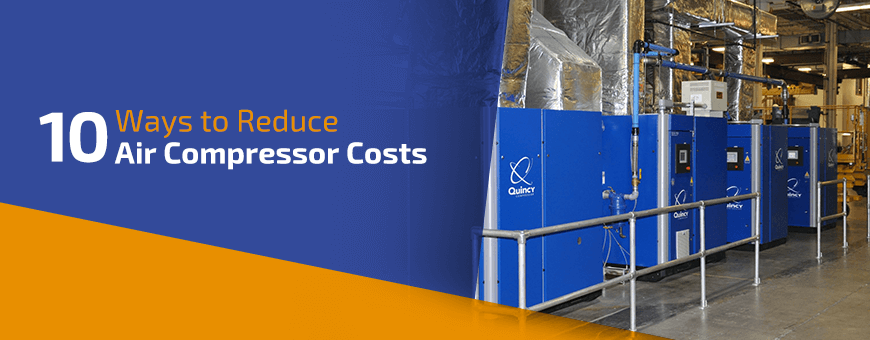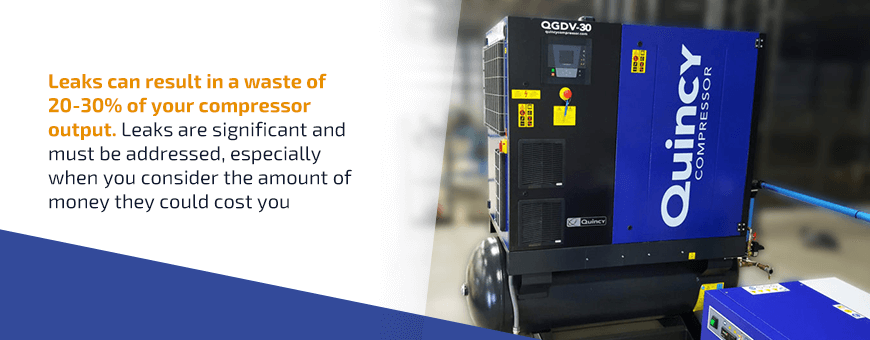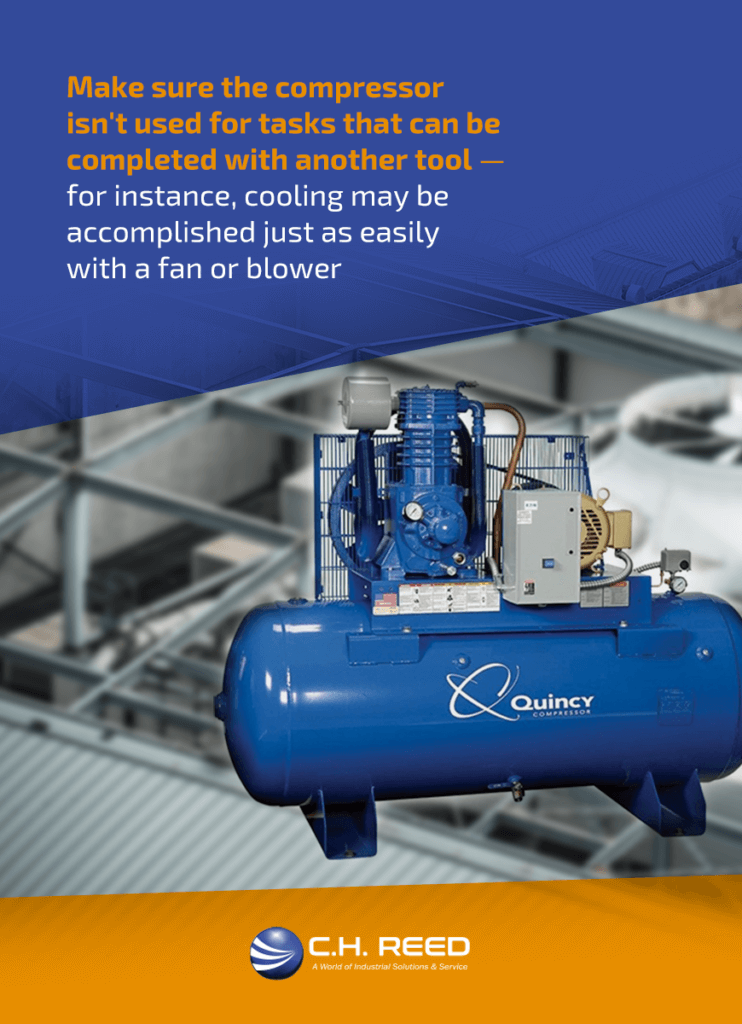September 3, 2019
10 Ways to Reduce Air Compressor Costs
SHARE THIS POST

Air compressors can be one of the most vital tools in an industrial workplace. They complete a variety of tasks, including painting, drilling, and sanding.
Compressors can also draw significant electricity — up to 30% of a site’s total electrical bill. This expenditure is why you need to take steps to maximize your compressor system’s efficiency.
Not sure how to save money with air compressors in your facility? Proper maintenance, routine care and a tailored preventative maintenance plan from C.H. Reed can be beneficial to you in saving money and time.
How to Reduce Air Compressor Maintenance Costs for Your Facility
It takes about 8 horsepower of electrical energy to generate the electricity required for 1 horsepower of compressed air. This ratio is why it’s crucial to find and address compressed air saving opportunities within your facility.
1. Select the Right Compressor
The first step in reducing compressor costs is using the right compressor for the job. There are several different types, each of which offers various benefits.
- Rotary screw air compressors: A popular and versatile choice, the rotary screw air compressor offers a reliable supply of clean and dry air. These compressors tend to have lower operating costs and can lead to a positive return on investment. Some rotary screw air compressors have variable speeds, so you can adjust energy usage as needed. This kind of compressor can be cooled efficiently, providing better operation in high temperatures and humidity levels. They are also quieter and have flexible control options.
- Reciprocating air compressors: These compressors are intended for intermittent use with noncontinuous amounts of air for shorter time periods. Reciprocating air compressors use less horsepower, offering more energy efficiency and savings.
- Centrifugal air compressors: Centrifugal air compressors cover a wide range of applications and have very high horsepower options. Their maintenance requirements are straightforward, with no internal-wearing parts besides seals and bearings. They are effective at full capacity and are best for applications with a constant demand.
- Vacuum pump compressors: By combining compressed air and the suction from a vacuum pump, you force air out of a chamber and create suction. Several different types of vacuum pumps exist, which means many industries — including automotive, plastics and medical, to name a few — can find a practical application.
- Oil-free air compressors: All the compressors listed above offer oil-free options, for applications where no oil can contaminate the air supply. These are especially useful in environments such as hospitals, pharmaceuticals, food processing plants, labs and dental offices.
If you need a new compressor, C.H. Reed has the solution you need for the job.
2. Fix and Prevent Leaks

Leaks can result in a waste of 20-30% of your compressor output. Leaks are significant and must be addressed, especially when you consider the amount of money they could cost you. A 1/8-inch hole in a 100 psi system can cost more than $1,200 per year in energy costs. Repairing leaks can help reduce run time and maintenance and extend the life of your equipment.
You can sometimes hear leaks, but often they are not audible and you’ll help need to find them. Ultrasonic leak detectors are a common way of doing so. A planned maintenance check can provide a regular search for leaks in an air compressor system.
After fixing any existing leaks, you’ll want to prevent new ones from occurring. The inside of the piping system could tell you about the air moving through it and whether leaks are present. It should be clean and dry with no corrosion. Contamination in the pipe could indicate contamination in the air quality. Also keep an eye out for rust, which indicates moisture and can lead to leaks and air resistance within the pipes.
3. Change Filters and Optimize Dryer Usage
One crucial factor in keeping those pipes dry and clean is to use the proper filters and change them often. Do not attempt to change filters on an “as-needed basis.” Change filters according to a set schedule. Dirty filters inhibit the compressor’s ability to push air along the system and require more energy to do so. Replacing dirty filters is a simple and effective way to improve air compressor performance.
A dryer may or may not be necessary for your system. It depends on your usage. You’ll want to avoid drying more air than necessary, as this can be wasteful. Talk to one of our representatives for more information about drying solutions for your compressor system.
Selecting your filters is also important. You need to choose the type of filter that is necessary for your application, including filters meant for oil separation, high temperatures and particle filtration. Filters can also vary based on the technical specifications of your compressor.
4. Reduce System Pressure
Any point in your system that uses an air compressor could be exposed to unnecessary usage. For every increase of 2 psi, you also increase energy consumption by 1 percent. Cranking up the pressure or even purchasing a more powerful compressor to compensate for leaks or dips in pressure may sound like a good idea, but it will just waste more energy. This approach doesn’t address the fact that there is likely an underlying issue dampening the pressure, such as a clogged filter or leak. If you increase the pressure, you could be pushing more air out of the system.
Ensure that you are matching the pressure required to operate a machine to the pressure you are drawing from the compressor. A machine that pulls more air than it needs discharges that extra air after usage.
Your system’s overall design could be a factor in pressure reduction as well. A well-designed system should have a pressure loss of less than 10% of the compressor’s discharge pressure. After-coolers, separators, dryers and poor connections are some common culprits for this, especially when stacked since each one contributes to slower airflow. Our team at C.H. Reed can review your entire system and offer upgrades to improve efficiency and productivity.
5. Optimize Compressor Usage
Only run your compressed air system when it is needed. Unless your facility uses it 24/7, there are likely non-peak times when you can power down the air compressor.

Make sure the compressor isn’t used for tasks that can be completed with another tool — for instance, cooling may be accomplished just as easily with a fan or blower.
A sound control system can increase a compressor’s efficiency by working with both the compressor and the equipment it powers. Fine-tuned controls cue the compressor to release pressure, monitor flow and other, more complex parameters that will help it run better.
Some of the control types that a compressor may have include:
- Start/stop: A self-explanatory control that should not be used for applications with frequent cycles. Repeated starts can overheat the motor and other components.
- Load/unload: This is a constant speed control that only unloads the compressor when the discharge pressure reaches a certain level. Some of these can be inefficient since they continue to run the machine while not offering any real work.
- Modulating: Throttling or modulating control varies the compressor output to meet flow requirements. This adjustment is usually done by closing the inlet valve. This control system is more effective on centrifugal compressors and cannot be used on reciprocating or lubricant-free screw compressors.
- Dual control/auto dual: These controls are for small reciprocating compresses and allow for selecting either start/stop or load/unload options.
- Variable displacement: Variable displacement can operate in two or more partially loaded conditions. This system allows for close control of output pressure without requiring a start/stop or load/unload of the compressor. Variable displacement controls have steps to them — 0%, 50%, 100%, etc. — which influence the power consumed.
6. Zero-Loss Drains
To get rid of all the water that compressors generate, you need an effective drain system. Automatic systems save time and labor. Manual and timed drains can waste precious air and could be less effective in a humid environment.
Zero-loss drains detect moisture and only open when it is present, meaning no compressed air is released. Also, make sure that you are cleaning the drain often.
7. Cool Intake Air
Cool air is naturally more compressed than hot air and requires less energy to be fully compressed than warm air. Moving your compressor intake to a cooler area can improve performance. A 20℉ drop in temperature can lower operating costs by almost 3.8%.
8. Recover Heat Generated
The heat generated from an air compressor often goes unused. Up to 90% of this heat can be reused with a heat recovery unit. Typical uses include heating water for use in bathrooms or heating areas of the facility, such as work areas or warehouses, during cold weather.
If just 50% of heat loss is recovered to process water, at $0.50 per therm, you can save about $4,100 per year in natural gas costs.
9. Review Your Infrastructure
Knowing many of the factors that influence compressed air savings, it may be time to reevaluate the design of your air compressor system.
- Airflow: You can help the airflow by reducing the number of sharp turns and bends in the pipes. Each time the air passes through a bend in the system, it sees added friction, which creates heat and slows the air down. The heat can contribute to wear on the compressor parts and pressure drops.
- Airpath: Reduce the distance that air has to travel as much as possible. The shorter the distance, the easier it is for the air to travel through the pipe.
- Heat recovery system: A heat recovery system can save you thousands and is much more energy-efficient than going without. Make sure the heat generated from your compressor doesn’t go to waste.
- Control system: Using an effective control system can increase efficiency and make your air compressor more responsive to the different machinery it works with. It may be worth upgrading to a better control system if yours doesn’t offer what you need.
- Pressure considerations: Most additions to an air compressor, like dryers, filters and separators, will slow down the process and result in pressure drops. Think twice about their implementation. Make sure that these are necessary and as efficient as possible. Choose options that impact pressure as little as possible.
- Operational procedures: Make filter changes and drain cleaning a regular and systematic process. These should not be done “as-needed,” as this can result in inconsistency and neglect.
C.H. Reed has team members with the expertise to redesign an inefficient system. They can provide suggestions and solutions to get your system running productively to reduce downtime and save costs.
10. Monitor Air Compressor Usage
Before optimizing your system, record your data. Research the energy consumption, airspeed and costs associated with your air compressor. Jot down the kW/h that you use, how much you pay for it and how long it runs. Then, determine the total cost.
You’ll also want to determine the energy demands of your facility. How much energy does your equipment require? Are you providing enough pressure for the highest demand or the minimum? Determine if you can limit energy use during high-demand times or turn the compressor down or off. Coordinate the information you’ve gathered about your operating habits with the information about electricity charge rates. You may be able to lower output during these times or consolidate usage to one compressor instead of three.
Compare the data from any proposed changes to the cost of your baseline. How do the costs line up? Once you’ve determined the configurations of usage that will reduce compressed air spending, you can review the layout of your site. This part of the process includes the locations of the equipment that will be using compressed air and the path that the air will have to take to get to them. Eliminating bends in pipes and even expanding pipe size are some things to consider.
Develop benchmarks and energy goals that you would like to reach. Keep a record of this information and update your findings after you’ve optimized your system.
How Air Compressor Preventative Maintenance Can Help
An air compressor is a complex piece of equipment that needs constant monitoring to stay operating at peak efficiency.
The price of electricity for a leaky and clogged air compressor can make up a significant part of your utility budget. Maintenance costs can be minor when compared to replacing or fixing a broken machine. Even if your equipment still works fine, it may be costing you money in energy expenses. If you haven’t performed regular maintenance on your equipment, leaks, dirty filters and inefficient practices can all cause your electricity bill to skyrocket.
Reducing these can save not only money but also time. By preventing costly breakdowns and slow work practices due to decreased pressure, you can ensure that your facility is running on all cylinders. Regular maintenance can decrease downtime overall by increasing the efficiency and operational speed of your air compressor.
About Our Planned Maintenance Packages — Contact Us to Learn More!
C. H. Reed has decades of compressed air industry experience throughout Pennsylvania, Maryland, Delaware, Virginia, West Virginia, Ohio and southern New York. Our preventative maintenance plans cover a wide range of air compressors and are specific to the type of machinery your facility has. We can even monitor your system remotely and keep an eye on its performance.
Depending on your equipment, maintenance may include but is not limited to checks for:
- Condensate drains
- Alarm and trips
- Operating data
- Air/oil leaks
- Noise inspection
- Air/oil filter element replacement
- Control panel history
To set your workplace on a path of energy efficiency, air compressor preventative maintenance is a great way to bring in benefits for your equipment, your investments and the planet. It is one of the easiest ways to generate compressed air savings.
Contact us today to learn more about implementing preventative maintenance in your facility — and putting more money in your pocket.
Search
Categories
Get a consultation
Related Posts
The 3 Distinct Advantages of Hydraulic Powered Pumps
Recently, C. H. Reed helped a major printing operation install a new ink pumping system. The new system needed to transfer four colors of high viscosity, heat-set ink to their three presses, drawing the ink from multiple 5,000…
Simple Ways to Reduce Waste in Your Spray Finishing System
In today’s demanding manufacturing landscape, it can be convenient to adopt a “cut-costs-at-all-costs” mentality, justifying questionable means for the sake of leaner production, a lower bottom line and increased profitability. Regrettably, those efforts can interfere…
What You Need to Know About Air-Powered Pressure Washers
Pressure washers are great solutions for your average cleaning applications, but what tool do you turn to for your more challenging applications? There are many instances where it is simply impossible to use a traditional…
